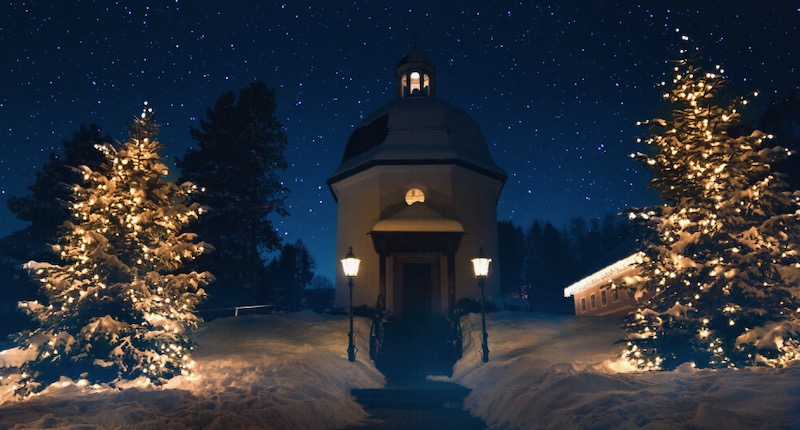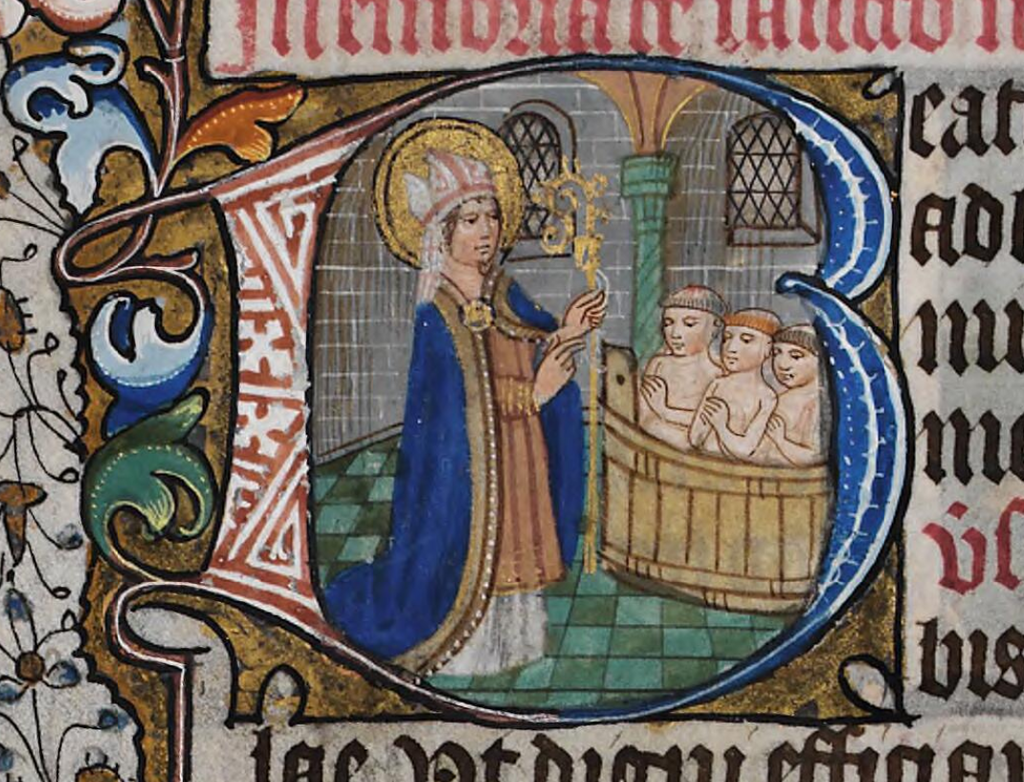I’m going to make a seemingly embarrassing confession for a grown man: I’m eagerly awaiting the arrival of Santa Claus. Please pause the snorts of derision or eye-watering laughter occasioned by my apparent Peter Pan complex. I’m not referring to the red-clad, white-bearded, present-bestowing, fat bloke who’s such as feature of Christmas celebrations today. Rather, the figure of my affections is the Santa Claus, or to give him his English name, St Nicholas, whose holy day falls on 6 December. One of the most popular saints of the Middle Ages, observance of his feast in early Advent gave a foretaste of the splendours and jollity of the coming Christmas season. Moreover, St Nicholas’ association with children in the Middle Ages was every bit as prominent as that of his modern Americanised and thoroughly bastardised namesake, and as I’ll explain, found an especially intriguing and engaging expression in the form of “boy bishops”.
All that is known of the historical St Nick is that he was bishop of Myra, in what’s now southwestern Turkey, in the fourth century. Focus of a cult from at least the 700s, the saint’s veneration in Western Europe was turbo-charged in 1087 when his relics were translated, or moved, from their Asiatic homeland to Bari in southern Italy. St Nicholas’s shrine in the city’s cathedral rapidly became a popular pilgrimage destination.
By the thirteenth century, St Nicholas had acquired a fantastical legend, that recounts two deeds explaining why the saint came to have such an especial association with children. Somewhat ironically, neither is suitable for airing before the 9pm watershed. The first tells how three young maidens at risk of being sold into slavery, or to be more precise, prostitution, by their impoverished father were saved from this dreadful fate by the compassionate and munificent bishop who tossed three bags brimming with gold through their open window. The second recounts how a butcher murdered and dismembered three boys, their remains stored in a barrel of brine for sale to his unsuspecting customers as pork. Thanks to St Nicholas’s intercession, not only were the boys restored to life but the infanticidal butcher also atoned for his heinous sin and found redemption. These legends provided the basis for St Nicholas’ usual depiction in art, as a bishop carrying three golden balls, or alternatively, with three small, naked boys standing in a tub at his feet.
The saint’s feast on 6 December was universally observed. Not only did it have its own special Mass and services, but the saint’s particular association with children led to a custom developing in cathedrals, monasteries and other greater churches whereby a boy chorister was selected as a boy bishop on St Nicholas’s Day. The chosen lad would adopt the dress, dignity and even some of the responsibilities of a prelate for a limited period over the Christmas season.
Evidence for boy bishops – and girl abbesses at nunneries – survives from across medieval Europe. They became such an established feature of the ecclesiastical year that special statutes were drafted to regulate every aspect of the ceremonies and duties pertaining to their selection and tenure of pseudo-episcopal office.
At York Minster, the boy bishop, or “bairn bishop” in Yorkshire dialect, was the longest serving chorister, an added requirement being that he was “sufficiently handsome in person”. Elsewhere, choristers jealously guarded their right to freely elect the boy bishop of their choice. At Salisbury Cathedral, an attempt by a senior member of the clergy to interfere in the process was bitterly resisted by the choirboys, leading to the convening of a special meeting of the cathedral’s governing chapter which duly confirmed the boys’ historic rights and privileges in the matter.
Lavish celebrations accompanied the selection process. At Magdalen College, Oxford, the fellows treated the choristers to a special feast in the college hall on St Nicholas Day. There was more ceremony when the lucky lad assumed office during the late afternoon service of Vespers on 27 December – the eve of the feast of the Holy Innocents, or Childermas as it was called in England. It was an occasion of high liturgical theatre, the boy bishop displacing the bishop or abbot from his throne as his confreres intoned the words from the Magnificat, “he hath put down the mighty from their seat, and hath exalted the humble”. Proud prelates crashed down to earth with a bump during this instance of the role reversal, or inversion, which was such a notable, and frequently unruly, characteristic of medieval Christmas celebrations.
Accompanied by chorister “chaplains” and other officials, the boy bishop presided over all services on Childermas, the only exception being Mass. He even had the right to confer a form of benediction, or blessing, a solemn privilege normally reserved for priests.
Cathedral and monastic sacristies across Europe were filled with diminutive vestments for the adornment of boy bishops. Such treasures included a mitre at St Paul’s Cathedral, London, a richly embroidered cope at Lincoln and several foundations laid claim to tiny bejewelled crosiers. Choirboys were provided with copes for the processions led by their boy bishop, and at Magdalen College these nascent clergymen carried a banner decorated with the highly appropriate image of St Nicholas, the patron saint of children.
In keeping with the spirit of the season and the charitable responsibilities of the Church, boy bishops distributed largesse to children, the poor and the needy. Tangible evidence of such generosity is provided by the small, coin-like lead tokens that have been excavated in large numbers, especially in East Anglia. Most are stamped with episcopal mitres, many also bearing a legend requesting the prayers of St Nicholas. The great Benedictine abbey at Bury St Edmunds was especially associated with their production and distribution, the tokens likely exchanged for sweetmeats and other festive treats at the abbey’s almonry.
In so many ways, St Nicholas and the ceremonies accompanying his feast are the Middle Ages in microcosm: miraculous, magnificent and more than a little bit mad. In middle age, I’m as captivated by St Nicholas as I was by Santa Claus as a little boy.



 Loading ...
Loading ...
What do you think?
You can post as a subscriber user ...
User comments (0)